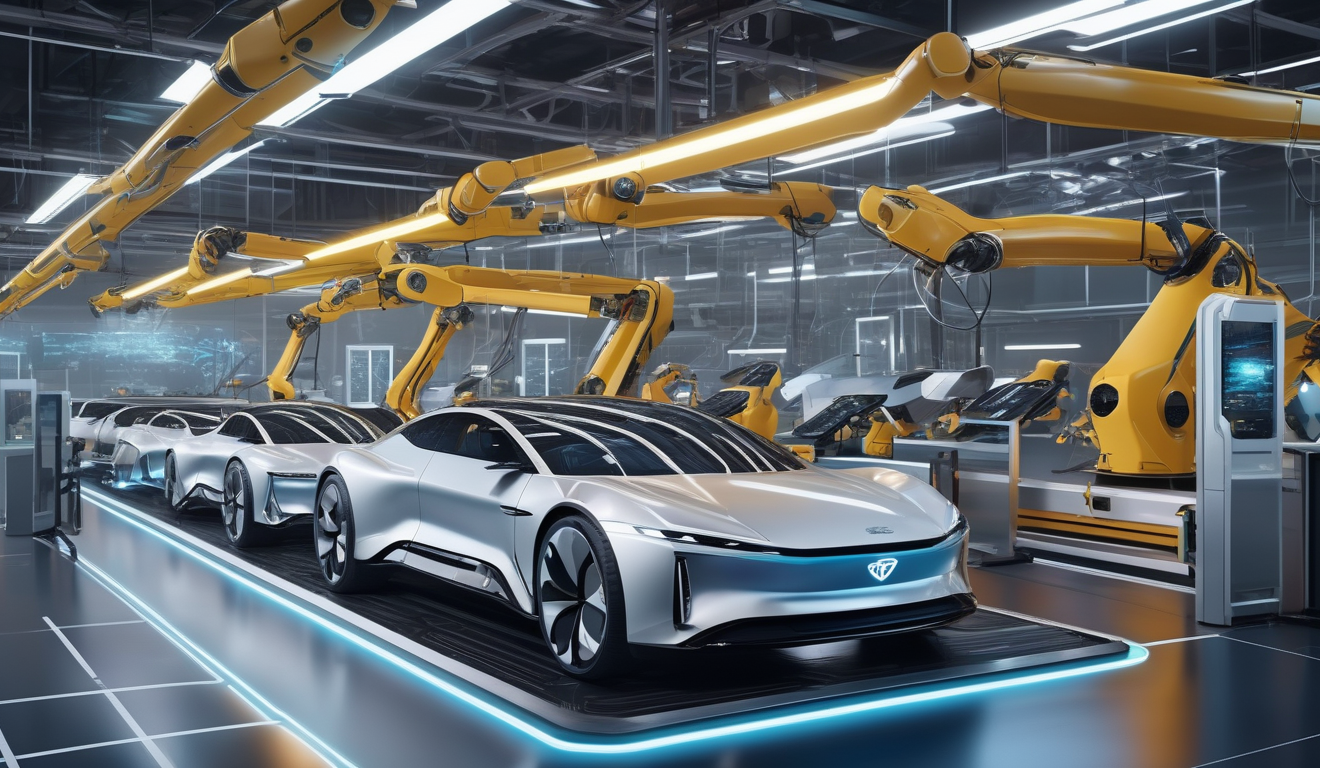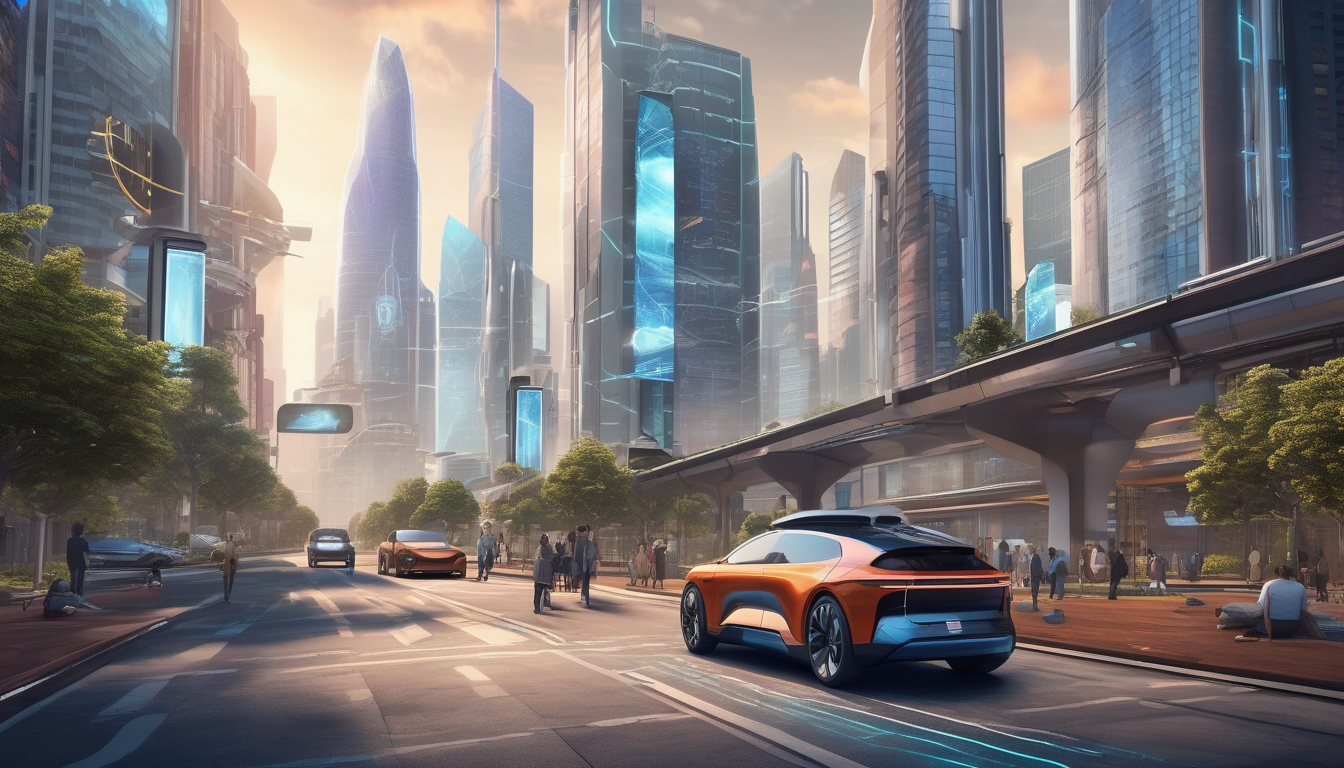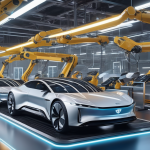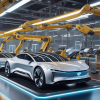How Technology is Transforming the Automotive Industry

The automotive industry is undergoing a remarkable transformation, driven by rapid technological advancements that are reshaping every aspect of vehicle design, manufacturing, and usage. From the rise of electric vehicles (EVs) to the development of autonomous driving technologies, the changes are not just incremental; they’re revolutionary. Imagine a world where cars are not only environmentally friendly but also capable of driving themselves, allowing you to relax or catch up on work during your commute. This is not science fiction anymore; it’s happening right now!
One of the most significant shifts is the electric vehicle revolution. With advancements in battery technology and charging infrastructure, EVs are becoming a practical alternative to traditional gasoline-powered cars. They offer numerous benefits, including reduced emissions and lower operating costs. As charging stations become more widespread, the range anxiety that once plagued potential EV buyers is fading away. In fact, many manufacturers are committing to a future dominated by electric mobility, making it clear that the shift is not just a trend but a necessity for sustainability.
Another exciting frontier is autonomous driving. This technology promises to redefine our relationship with cars. Imagine cars that can communicate with each other, predict traffic patterns, and navigate through complex urban environments with ease. With innovations in sensors, artificial intelligence, and machine learning, these vehicles are becoming smarter every day. They are equipped with advanced safety features like collision avoidance systems and adaptive cruise control, significantly reducing the chances of accidents. It’s like having a co-pilot who never gets tired!
However, with these advancements come new challenges, particularly in the realm of insurance and liability. As cars become more autonomous, the question of who is responsible in the event of an accident becomes increasingly complex. Insurers are now faced with the task of adapting their policies to accommodate this new reality, ensuring that both manufacturers and drivers are protected.
Moreover, the automotive industry’s embrace of smart manufacturing techniques is transforming production lines. The integration of IoT, robotics, and data analytics is streamlining processes, reducing waste, and enhancing efficiency. Robots are taking over repetitive tasks, allowing human workers to focus on more complex responsibilities. This not only boosts productivity but also ensures higher quality standards in vehicle assembly.
In conclusion, technology is not just changing how we drive; it’s revolutionizing the entire automotive landscape. As these innovations continue to unfold, we can expect a future filled with safer, cleaner, and more efficient vehicles that will change the way we live and move.

Electric Vehicles Revolution
The rise of electric vehicles (EVs) is nothing short of a revolution in the automotive landscape. As we zoom into the future, technological innovations are reshaping how we think about transportation. Imagine a world where cars are not just machines, but eco-friendly companions that help reduce our carbon footprint. This transformation is fueled by advancements that enhance battery life, expand charging infrastructure, and promote environmental sustainability. With these improvements, EVs are becoming a viable alternative to traditional gasoline-powered cars, making the road to a greener future brighter than ever.
One of the most exciting aspects of this electric revolution is the rapid development of charging stations. No longer do drivers need to worry about running out of juice on long trips. With the proliferation of charging stations, it’s becoming easier to find a plug than a gas station! The convenience of fast-charging technology means that you can recharge your vehicle while grabbing a coffee or running errands, seamlessly integrating into your busy lifestyle.
Moreover, the environmental benefits of EVs are profound. By switching from gasoline to electric, we can significantly reduce greenhouse gas emissions. According to recent studies, EVs can cut emissions by up to 70% compared to traditional vehicles over their lifetime. This shift is crucial in combating climate change and fostering a sustainable future for generations to come.
However, it’s not just about the environment; the economic impact of electric vehicles is also noteworthy. As more consumers opt for EVs, the automotive industry is witnessing a surge in job creation within the green technology sector. This shift not only promotes innovation but also opens up new avenues for skilled labor, driving economic growth in various regions.
In summary, the electric vehicle revolution is not merely a trend; it’s a fundamental shift in how we approach transportation. With advancements in technology, infrastructure, and environmental consciousness, the future of driving is electric. Are you ready to embrace the change and join the movement towards a cleaner, greener planet?

Autonomous Driving Innovations
The world of autonomous driving is not just a trend; it’s a revolution that is reshaping how we think about transportation. Imagine a future where your car drives itself, allowing you to focus on what truly matters—like catching up on your favorite show or enjoying a peaceful nap. This isn’t science fiction; it’s happening now, thanks to remarkable advancements in technology.
At the heart of this transformation are sensors, artificial intelligence, and machine learning. These innovations are like the brain and eyes of a self-driving car, enabling it to navigate complex road conditions with ease. For instance, the integration of sophisticated sensors allows vehicles to detect obstacles, pedestrians, and other vehicles in real-time, making split-second decisions to ensure safety. It’s akin to having a superhuman ability to see and react faster than any driver could.
One of the most exciting aspects of autonomous driving is the enhanced safety features that come with it. Modern vehicles are now equipped with advanced technologies such as collision avoidance systems and adaptive cruise control. These features work together to significantly reduce the likelihood of accidents. Imagine driving on a busy highway where your car automatically adjusts its speed to maintain a safe distance from others. This not only enhances safety but also makes the driving experience more enjoyable and stress-free.
To achieve such remarkable capabilities, autonomous vehicles rely heavily on LiDAR and other sensor technologies. LiDAR, which stands for Light Detection and Ranging, uses laser beams to create a detailed 3D map of the vehicle’s surroundings. This high-resolution data allows cars to navigate through complex environments, like bustling city streets or winding country roads, with precision. Think of it as giving your car a pair of super-sensitive eyes that can see everything around it, even in the dark.
Furthermore, machine learning algorithms play a pivotal role in enhancing the intelligence of autonomous vehicles. These algorithms analyze vast amounts of data collected from various driving scenarios, enabling the car to learn and adapt over time. As a result, the vehicle becomes smarter with every trip, improving its decision-making capabilities. It’s like training a pet; the more experiences it has, the better it becomes at responding to different situations.
In conclusion, the innovations in autonomous driving are paving the way for a safer, more efficient, and ultimately, more enjoyable driving experience. As we continue to embrace these technological advancements, the future of transportation looks brighter than ever.
Safety Features in Autonomous Vehicles
The emergence of autonomous vehicles is not just about convenience; it’s fundamentally about enhancing road safety. With the integration of advanced technologies, these vehicles are equipped with a plethora of safety features designed to minimize risks and protect passengers. Imagine a world where your car can anticipate dangers before you even notice them—this is becoming a reality thanks to innovations in collision avoidance systems and adaptive cruise control.
One of the standout features is the collision avoidance system, which uses sophisticated sensors and algorithms to detect potential obstacles. This technology is akin to having a second pair of eyes on the road, constantly scanning for hazards. When a potential collision is detected, the system can automatically apply the brakes or steer the vehicle away from danger, significantly reducing the likelihood of accidents.
Moreover, adaptive cruise control takes the stress out of long drives. Unlike traditional cruise control, which maintains a constant speed, this smart feature adjusts your vehicle’s speed according to the traffic around you. It’s like having a personal chauffeur who keeps you safe and comfortable, allowing you to relax during your journey.
To give you a clearer picture, let’s break down some of the key safety features found in modern autonomous vehicles:
- Lane Keeping Assist: Helps drivers stay in their lanes by providing steering assistance.
- Automatic Emergency Braking: Engages the brakes automatically if a collision is imminent.
- Blind Spot Monitoring: Alerts drivers to vehicles in their blind spots, enhancing lane change safety.
These features work in harmony, creating a comprehensive safety net that not only protects the driver but also enhances the overall driving experience. As technology continues to evolve, we can expect even more sophisticated safety measures to emerge, making autonomous vehicles a safer choice for everyone on the road.
LiDAR and Sensor Technology
In the realm of autonomous vehicles, LiDAR (Light Detection and Ranging) technology stands out as a game-changer. It functions like a pair of advanced eyes for cars, enabling them to “see” their surroundings in stunning detail. By emitting laser beams and measuring the time it takes for them to bounce back, LiDAR creates a precise 3D map of the environment. This technology is crucial for navigating complex urban landscapes and ensuring safe driving.
But LiDAR isn’t working alone; it’s part of a broader ecosystem of sensor technologies that include cameras, radar, and ultrasonic sensors. Each of these components contributes unique capabilities, making the vehicle’s perception system robust and reliable. For instance, while cameras excel at recognizing traffic signs and lane markings, radar can detect the speed and distance of nearby vehicles, even in poor weather conditions.
When combined, these technologies allow autonomous vehicles to:
- Detect obstacles in real-time.
- Understand traffic patterns and signals.
- Make split-second decisions to avoid collisions.
Moreover, the integration of these sensors into a cohesive system enhances the vehicle’s ability to operate safely and efficiently. Data from these sensors is processed using advanced algorithms, enabling the car to learn and adapt to various driving scenarios. Imagine a vehicle that not only navigates through city streets but also anticipates the actions of pedestrians and cyclists. This level of awareness transforms the driving experience, making it safer for everyone on the road.
As we look to the future, the evolution of LiDAR and sensor technology will continue to push the boundaries of what’s possible in autonomous driving. With ongoing advancements, we can expect these systems to become even more sophisticated, paving the way for a new era in transportation where safety and efficiency are paramount.
Machine Learning in Driving
Machine learning is a game-changer in the automotive industry, particularly when it comes to autonomous driving. Imagine your car being able to learn from every trip, adapting its behavior and improving its decision-making abilities over time. That’s exactly what machine learning enables. By processing vast amounts of data collected from various sensors, cameras, and other inputs, these vehicles can analyze real-world driving scenarios and refine their algorithms accordingly.
For instance, every time an autonomous vehicle encounters a new situation—like navigating through a crowded city street or reacting to unexpected obstacles—it gathers data that enhances its understanding of the environment. This continuous learning process not only helps the vehicle to react more effectively but also contributes to overall road safety. The more data the vehicle processes, the better it becomes at predicting potential hazards, which is crucial for preventing accidents.
Moreover, machine learning algorithms allow cars to recognize patterns and make informed decisions. Here are some key aspects of how machine learning is transforming driving:
- Real-time Decision Making: Vehicles can analyze data in real-time, enabling them to make split-second decisions that can save lives.
- Behavior Prediction: Machine learning helps in understanding and predicting the behavior of other drivers and pedestrians, leading to smoother traffic flow.
- Continuous Improvement: As the vehicle gathers more data, its algorithms are updated, allowing for constant improvements in driving performance.
In essence, machine learning is not just about making cars smarter; it’s about creating a safer and more efficient driving experience for everyone on the road. As technology continues to evolve, we can expect even more innovative applications of machine learning in the automotive sector, paving the way for a future where cars are not only autonomous but also incredibly intelligent.
Impact on Insurance and Liability
The emergence of autonomous vehicles is not just a technological marvel; it’s also a game-changer for the insurance industry. As cars become smarter and more capable of driving themselves, the age-old question of liability is taking on a new dimension. Who is responsible when a self-driving car gets into an accident? Is it the manufacturer, the software developer, or the owner? These questions are stirring up a whirlwind of discussions among insurers and lawmakers alike.
Traditionally, auto insurance has revolved around the driver’s behavior and the vehicle’s condition. However, with the rise of autonomous driving technology, the focus is shifting from the driver to the vehicle’s systems. Insurers are now faced with the challenge of reassessing their policies to accommodate this new reality. For instance, liability coverage may need to be redefined to include not just the driver but also the vehicle’s technology and the companies behind it.
To illustrate the potential changes in the insurance landscape, consider the following table that outlines the shift in liability:
| Scenario | Traditional Liability | Autonomous Vehicle Liability |
|---|---|---|
| Driver Error | Driver held responsible | Driver may not be liable |
| Vehicle Malfunction | Manufacturer may be liable | Software developer may share liability |
| Accident due to AI decision | N/A | Complex liability involving multiple parties |
This table highlights how the traditional understanding of liability is evolving. As autonomous vehicles become more prevalent, insurers will need to develop new models that accurately reflect the risks associated with automated driving. This includes potentially offering policies that cover software failures, cybersecurity threats, and even accidents caused by AI decision-making.
In conclusion, the rise of autonomous vehicles is not just about the technology itself; it’s also about how we redefine responsibility and accountability in a world where machines take the wheel. As the industry adapts, consumers will need to stay informed about how these changes will affect their insurance policies and what it means for their safety on the roads.

Smart Manufacturing Techniques
The automotive industry is undergoing a seismic shift with the adoption of . This transformation is powered by the integration of Internet of Things (IoT), robotics, and data analytics, which collectively enhance production efficiency and reduce operational costs. Imagine a factory floor where machines communicate seamlessly, adjusting their operations in real-time to optimize output. That’s the future we’re stepping into!
One of the most significant advancements is the use of IoT devices in manufacturing. These devices collect and share data from various parts of the production process, allowing manufacturers to monitor performance and identify areas for improvement. For example, if a machine is running slower than usual, alerts can be sent to operators, who can then investigate and resolve the issue before it leads to costly downtime.
Robotics also plays a crucial role in this smart manufacturing revolution. Robots are no longer just tools; they are becoming collaborative partners on the assembly line. They perform repetitive tasks with incredible precision, which not only speeds up production but also minimizes human error. As a result, manufacturers can maintain high-quality standards while meeting increasing consumer demands.
Moreover, the implementation of data analytics enables manufacturers to make informed decisions based on real-time data. By analyzing production metrics, companies can spot trends, forecast maintenance needs, and even streamline supply chains. This proactive approach leads to significant cost savings and improved output quality. For instance, a manufacturer might discover that a particular component frequently causes delays, prompting them to adjust their supply chain accordingly.
| Smart Manufacturing Benefits | Description |
|---|---|
| Increased Efficiency | Automation and IoT reduce manual labor and streamline processes. |
| Cost Reduction | Data analytics help identify waste and optimize resource allocation. |
| Enhanced Quality Control | Robots ensure consistent quality by performing tasks with precision. |
In conclusion, the shift towards smart manufacturing techniques is not just a trend; it’s a necessity for staying competitive in today’s fast-paced automotive market. As technology continues to evolve, we can expect even more exciting innovations that will further enhance efficiency and safety in vehicle production. So, buckle up and get ready for a thrilling ride into the future of automotive manufacturing!
Robotics in Production Lines
The automotive industry is witnessing a revolution in its production lines, thanks to the integration of robotics. These advanced machines are not just tools; they are transforming the way vehicles are manufactured. Imagine a world where cars are assembled with the precision of a surgeon—this is not science fiction; it’s happening right now! Robotics enhances productivity and ensures that every vehicle meets the highest quality standards.
One of the most significant advantages of using robots in production is their ability to work around the clock without fatigue. While human workers need breaks and can suffer from errors due to tiredness, robots can operate continuously, leading to increased output. This relentless efficiency allows manufacturers to meet growing consumer demands without compromising quality.
Moreover, robots excel in performing repetitive tasks that require high precision. For instance, tasks such as welding, painting, and assembling components can be done with remarkable accuracy. This not only reduces the chances of human error but also enhances the overall safety of the workplace. To put it simply, robots are like the unsung heroes of the factory floor, tirelessly ensuring that every part fits perfectly.
As the automotive sector embraces this technology, we see a shift in job roles as well. While some fear that robots will take away jobs, the reality is that they create new opportunities. Workers are now required to oversee robotic operations, troubleshoot issues, and maintain these sophisticated machines. This shift necessitates a workforce that is skilled in both technology and traditional manufacturing methods.
In conclusion, the integration of robotics in production lines is not just about replacing human labor; it’s about enhancing the entire manufacturing process. With their ability to perform tasks efficiently and accurately, robots are paving the way for a new era in the automotive industry. As we look to the future, it’s clear that the collaboration between humans and robots will lead to even more innovations, making the dream of a fully optimized production line a reality.
Data Analytics for Efficiency
In the fast-paced world of automotive manufacturing, data analytics has emerged as a game-changer, acting like a compass that guides companies toward greater efficiency and productivity. By harnessing the power of data, manufacturers can uncover insights that were previously hidden in the noise of daily operations. Imagine trying to find a needle in a haystack; that’s what it was like before data analytics stepped in to streamline the process.
One of the key benefits of data analytics is its ability to identify bottlenecks in the production line. For instance, when a conveyor belt slows down or a machine malfunctions, it can lead to costly delays. With real-time data monitoring, manufacturers can spot these issues as they arise, allowing for immediate intervention. This proactive approach not only saves time but also reduces waste, which is crucial in an industry where margins can be razor-thin.
Moreover, data analytics enables predictive maintenance, which is akin to having a crystal ball for machinery. By analyzing patterns and trends in machine performance, manufacturers can foresee when a piece of equipment is likely to fail. This foresight allows them to schedule maintenance before a breakdown occurs, minimizing downtime and ensuring that production flows smoothly. In fact, studies show that predictive maintenance can reduce maintenance costs by up to 30%.
To illustrate the impact of data analytics on efficiency, consider the following table:
| Benefit | Impact on Efficiency |
|---|---|
| Bottleneck Identification | Reduces delays and optimizes workflow |
| Predictive Maintenance | Minimizes downtime and extends equipment life |
| Supply Chain Optimization | Enhances inventory management and reduces costs |
In addition to these aspects, data analytics also plays a vital role in inventory management. By analyzing sales trends and customer preferences, manufacturers can better predict what parts and materials they need, thus avoiding overstocking or stockouts. This level of efficiency not only saves money but also enhances customer satisfaction, as products are available when needed.
In conclusion, the integration of data analytics into automotive manufacturing is not just a trend; it’s a necessity for companies looking to thrive in a competitive landscape. By leveraging data, manufacturers can make informed decisions that lead to improved efficiency, reduced costs, and ultimately, a better product for consumers.
Frequently Asked Questions
- What are electric vehicles (EVs)?
Electric vehicles (EVs) are cars that run on electricity instead of gasoline or diesel. They use rechargeable batteries to power an electric motor, which makes them more environmentally friendly and often cheaper to operate than traditional vehicles.
- How does autonomous driving technology work?
Autonomous driving technology relies on a combination of sensors, cameras, and artificial intelligence to navigate and control a vehicle without human intervention. These systems gather data from the vehicle’s surroundings, allowing it to make real-time decisions for safe driving.
- What safety features are found in autonomous vehicles?
Modern autonomous vehicles boast a variety of safety features, including collision avoidance systems, adaptive cruise control, and emergency braking. These technologies work together to minimize the risk of accidents and enhance the overall safety of the driving experience.
- What role does machine learning play in autonomous driving?
Machine learning is crucial for autonomous vehicles as it allows them to learn from vast amounts of driving data. This technology helps improve their decision-making capabilities, making them safer and more efficient over time.
- How is technology impacting automotive manufacturing?
Technology is revolutionizing automotive manufacturing through smart manufacturing techniques, such as the Internet of Things (IoT), robotics, and data analytics. These innovations streamline production processes, reduce waste, and enhance overall efficiency, resulting in better quality vehicles.
- What are the benefits of using robotics in production lines?
Robots in production lines increase productivity by performing tasks with precision and speed. They help maintain high-quality standards in vehicle assembly and reduce the risk of human error, leading to more reliable and efficient manufacturing processes.
- How does data analytics improve manufacturing efficiency?
Data analytics allows manufacturers to analyze production data to identify bottlenecks, predict maintenance needs, and optimize supply chain management. This leads to cost savings and increased output, making the manufacturing process more efficient overall.













